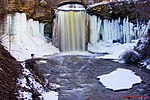Sisters of St. Francis of the Holy Cross
Belgian-American culture in WisconsinBuildings and structures in Brown County, WisconsinCatholic Church in WisconsinCatholic female orders and societiesCatholic religious institutes established in the 19th century ... and 2 more
Congregations of Franciscan sistersReligious organizations established in 1868

The Sisters of St. Francis of the Holy Cross are a diocesan community of religious women who live according to the Rule of St. Francis of Assisi in Northeastern Wisconsin. In essence, the sisters practice "simplicity, hospitality, and prayer that is centered on the Cross of Jesus Christ, the sacred Word of Scripture, and the Holy Eucharist."
Excerpt from the Wikipedia article Sisters of St. Francis of the Holy Cross (License: CC BY-SA 3.0, Authors, Images).Sisters of St. Francis of the Holy Cross
Nicolet Drive, Green Bay
Geographical coordinates (GPS) Address Nearby Places Show on map
Geographical coordinates (GPS)
| Latitude | Longitude |
|---|---|
| N 44.555722222222 ° | E -87.907333333333 ° |
Address
Nicolet Drive
Nicolet Drive
54311 Green Bay
Wisconsin, United States
Open on Google Maps






